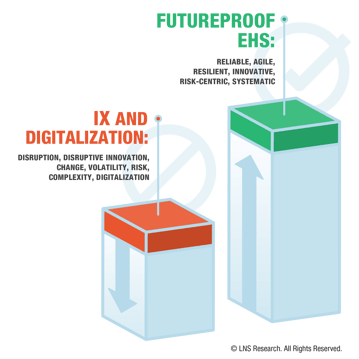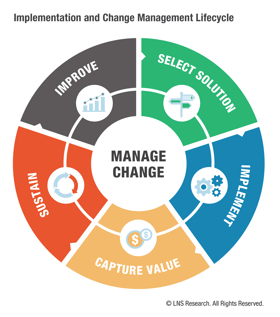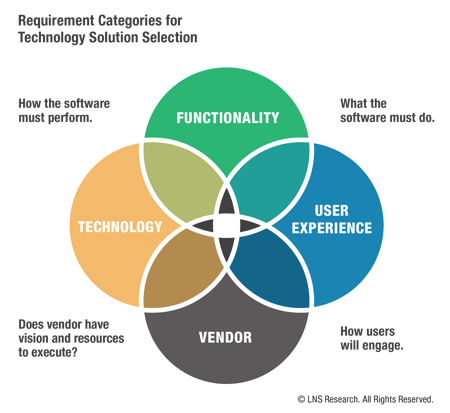Digital Transformation of industrial operations is in full swing. Our most recent survey data shows that 45% of industrial enterprises globally are executing an Industrial Transformation (IX) program, up significantly over the past three years. Don’t be fooled into thinking there’s a “magic formula” for IX; the “right” path for every company is the one that will reshape how the organization does business, the offerings it can deliver, how it goes about competing in the marketplace, or some combination of these. To that end, companies are incorporating many flavors of digital tech in their IX programs. Two-thirds have implemented or plan to implement Industrial Internet of Things (IIoT) technologies. Other common ones are cloud-based application platforms, mobile apps, Big Data analytics, augmented reality/virtual reality (AR/VR), process simulation, digital twins, and 3D printing, among many others.
 The IX trend has significant implications for the environment, health, and safety (EHS) business function in the form of both risk and opportunity. Despite companies’ eagerness to forge ahead quickly, EHS business leaders should take a moment to understand the challenges of selecting a primary EHS technology platform in the IX environment. Ultimately, they must take steps to help the organization make good solution selection decisions that will futureproof EHS systems, make them obsolescence-resistant, and maximize long-term value.
The IX trend has significant implications for the environment, health, and safety (EHS) business function in the form of both risk and opportunity. Despite companies’ eagerness to forge ahead quickly, EHS business leaders should take a moment to understand the challenges of selecting a primary EHS technology platform in the IX environment. Ultimately, they must take steps to help the organization make good solution selection decisions that will futureproof EHS systems, make them obsolescence-resistant, and maximize long-term value.
New Challenges, New Opportunities
The digital disruption of business models, processes, and how work gets done fundamentally alter an organization's risk profile and create new safety and operational risks that companies must manage. On the plus side, digital technologies that enable IX also provide new advanced capabilities for optimizing EHS processes and proactive risk management.
Remarkably, most industrial organizations ― large and small alike ― are still trying to manage EHS with some combination of manual processes, spreadsheets, homegrown applications, and standalone, fragmented commercial EHS software. In fact, the adoption rate of standardized, commercial EHS software is less than 30%.
With advances in technology and pressure to optimize EHS performance with fewer resources, many companies find themselves needing to select and implement an enterprise EHS software platform as a foundational enabler of EHS transformation. While this is an excellent opportunity for EHS business leaders, it’s a challenge in that many are not familiar with today’s best practices for software solution selection.
Enabling EHS Transformation
As with any business transformation, EHS transformation is fundamentally an organizational change management initiative. Our research consistently shows that company culture, along with change management, is the top execution challenge IX leaders face. Successful EHS transformation requires that EHS leaders make decisions and lead initiatives that will drive results in the short term while ensuring sustainability and value over the long haul — that is, they must futureproof EHS.
 Our main advice to those undertaking EHS transformation: Do not select technology in a vacuum. Instead, conduct solution selection within the context of the enterprise and its IX initiatives. When solution selection is isolated, change management becomes an insurmountable challenge: adoption stalls and usage wains. Successful solution selection requires a quantitative process to eliminate bias and a team that incorporates all relevant parts of the organization, including operations, information technology (IT), operational technologies (OT), and cross-functional business leaders.
Our main advice to those undertaking EHS transformation: Do not select technology in a vacuum. Instead, conduct solution selection within the context of the enterprise and its IX initiatives. When solution selection is isolated, change management becomes an insurmountable challenge: adoption stalls and usage wains. Successful solution selection requires a quantitative process to eliminate bias and a team that incorporates all relevant parts of the organization, including operations, information technology (IT), operational technologies (OT), and cross-functional business leaders.
Technology Decisions and A Framework to Futureproof EHS
The organizing principle of selecting obsolescence-resistant technology is evaluating its ability to meet requirements today and into the future. Companies that successfully futureproof EHS define and weigh requirements early in the process, well before they assess or shortlist candidate solutions. The requirements are the unique set of standards that the organization uses to judge potential solutions; the company bases them on business priorities, resources, and operational architecture.
A common mistake is to view requirements as only each vendor's ability to meet functional and technical specifications. A future-proof solution exceeds feature/function needs and addresses user experience, technology strategy, functional roadmap, vendor risk profile, and other prerequisites. A vendor's ability to meet the organization’s requirements will largely determine the total value it can deliver, which should be the ultimate benchmark.
Key solution requirement categories to futureproof EHS technology include:
- FUNCTIONALITY – the ability to enable specified processes and capabilities; application configurability and extensibility are essential considerations for solution agility
- USER EXPERIENCE (UX) – overall UX includes visual interface, ease of use, training requirements, and other factors that impact user adoption and system utility
- TECHNOLOGY – the platform(s) with which the software is built, embedded or pre-integrated tools, the ability to integrate and interoperate with other systems including OT, and other technical capabilities and limitations
- VENDOR – the company’s ability to deliver solutions today and in the future to meet current and anticipated requirements, including market position and presence, business and go-to-market strategy, financial and human resources, partner and customer ecosystem, organizational culture, and other factors that impact execution and long-term viability
 Making Progress Toward “Futureproof”
Making Progress Toward “Futureproof”
IX is the modern approach to Operational Excellence, and it’s no longer a question of whether the EHS business leader should engage in the company’s Industrial Transformation program―the question is how. Pragmatic EHS leaders are seizing the opportunity to align people, processes, and technology for organizational and technological agility in support of the corporation’s business objectives. As business leaders participate in IX, they should apply these guidelines to futureproof EHS for the enterprise:
- THINK TRANSFORMATION, NOT JUST TECHNOLOGY. To become truly future-proof the EHS business function should implement management systems and enable technology that aligns and integrates with IX programs.
- LEVERAGE IT/OT CONVERGENCE. The convergence of plant operational technologies with EHS business/IT systems can provide new data, information, and insights needed for predictive risk management.
- INCREASE MATURITY OF CAPABILITIES and foundational EHS systems. A prerequisite for EHS transformation is a solid foundation of data management, workflow, process automation, reporting, analytics, and others. For many organizations, this means implementing modern EHS software that is resistant to obsolesce.
- CONDUCT RIGOROUS SOLUTION SELECTION. Organizations making decisions about a new or replacement EHS platform must conduct a tightly managed, rigorous selection process to ensure success. Errors and omissions may cause harm downstream during implementation or the inability to sustain long-term value.
- FOCUS ON BUSINESS VALUE, not cost. Base decisions to invest in EHS transformation and enabling technology on total benefit over time, rather than cost. A value-based approach is the only way to ensure future-proof technology choices.